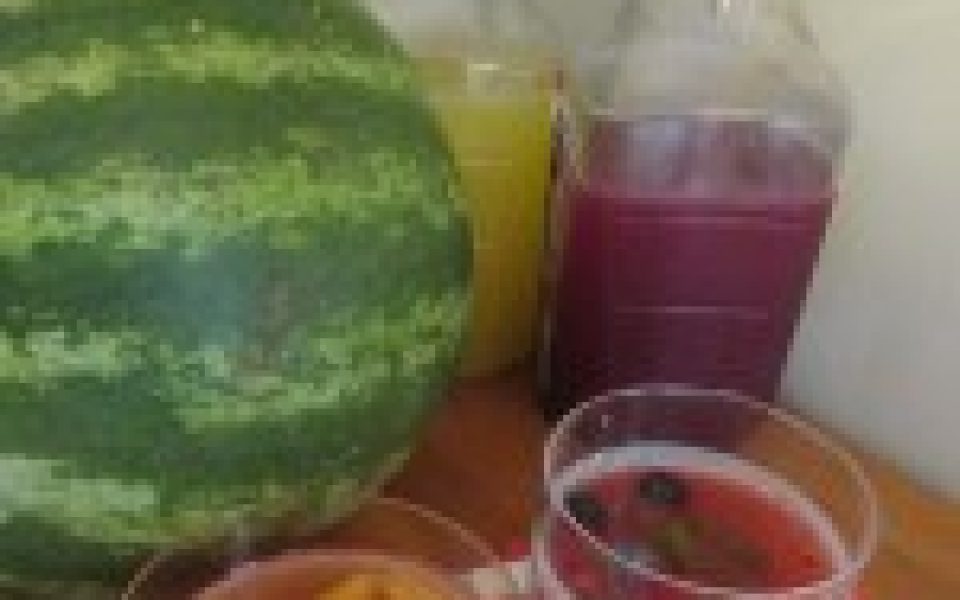by Eric Ginsburg
It seems fitting that, though I’ve intended to make it there for months, what finally brought me back to the Greensboro Farmers Curb Market was the pursuit of fresh fruit. And not just any fresh fruit, but berries and wedges to dump into a multi-gallon tank of sangria.
After an exhausting week at work, jumping out of bed on a Saturday morning to pack into a crowded room full of neighbors and vendors is about the last thing I want to do. I’m more inclined to pick a brunch venue in part based on the lack of a wait, or take the morning to regenerate alone.
The crowd had thinned considerably in the last hour of the curb market on the Fourth of July, making it easier to compare blueberry prices and mull over which tomatoes to add to a pasta salad for that evening.
I rarely work off a recipe, but creating enough sangria for a party requires more forethought than throwing random vegetables in a stir-fry. But the nice thing about making drinks, especially when working in large quantities, is the ability to improvise.
That’s how we ended up substituting eight peaches for the pineapple Kacie and I had planned to cut into star shapes, preferring the more flavorful and local alternative. We hadn’t considered that strawberries would already be out of season, but the recipe called for two cartons full and we zipped to a grocery store rather than compromise.
It was the first of several on-the-fly decisions for the sangria; I still can’t believe the ABC board is stupid enough to close on the Fourth of July — last-minute party-planners like me would more than cover the cost of overtime. With my bottle of Tito’s vodka running low, we added the remaining half-cup to four bottles of dry white wine (we chose sauvignon blanc) and poured in a half-cup of Sutler’s Spirit gin.
We compromised on the simple syrup too, more due to a lack of time than anything else, stirring half a cup of sugar directly into the mixture that also included a cup of lemon juice and about three cans of Fresca. We only had two hours to chill our creation and let the ingredients commingle before serving, but it was still a roaring success and tasted about the same the following afternoon.
As expected, friends arrived with six-packs of all sorts of beer, from Duck Rabbit to Victory, so much so that the PBR I bought as a reserve in case we ran out remained untouched. But the other star of the party — food and Grasshoppers’ fireworks aside — was a limoncello fruit cocktail.
 When my friend Ruth showed up and poured mango juice, blueberry lemonade, limoncello, basil, blueberries and strawberries into a drink dispenser, I was beyond the point of paying attention to proportions, instead drunkenly remarking to someone standing nearby that this is a tertiary reason to be friends with someone who used to be a liquor rep.
When my friend Ruth showed up and poured mango juice, blueberry lemonade, limoncello, basil, blueberries and strawberries into a drink dispenser, I was beyond the point of paying attention to proportions, instead drunkenly remarking to someone standing nearby that this is a tertiary reason to be friends with someone who used to be a liquor rep.
This, like the sangria, proved to be a smashing hit, and best when ladled into the cup through the top of the container so that the boozy berries could be part of the experience.
The next day, I added a dash Seagram’s ginger ale — the only store-bought kind worth messing with — to Ruth’s tart and tasty elixir, an easy way to put a little pep in its step.
There were plenty of other drink highlights to my weekend: a date-night stop at Liberty for the High Point brewery’s limited release of the Happy Hour in Karachi, which is its Deep River Wheat beer with the addition of hibiscus flowers and Pakistani rose buds, and a Sunday evening outing to Fat Dog’s — the first local bar I frequented after turning 21 — to watch the US women trounce Japan in the World Cup finale.
But it’s hard to match that homemade sangria with local ingredients, or the fruit smoothie-esque limoncello show-stealer, both of which will see an encore performance before long.
Join the First Amendment Society, a membership that goes directly to funding TCB‘s newsroom.
We believe that reporting can save the world.
The TCB First Amendment Society recognizes the vital role of a free, unfettered press with a bundling of local experiences designed to build community, and unique engagements with our newsroom that will help you understand, and shape, local journalism’s critical role in uplifting the people in our cities.
All revenue goes directly into the newsroom as reporters’ salaries and freelance commissions.


Leave a Reply